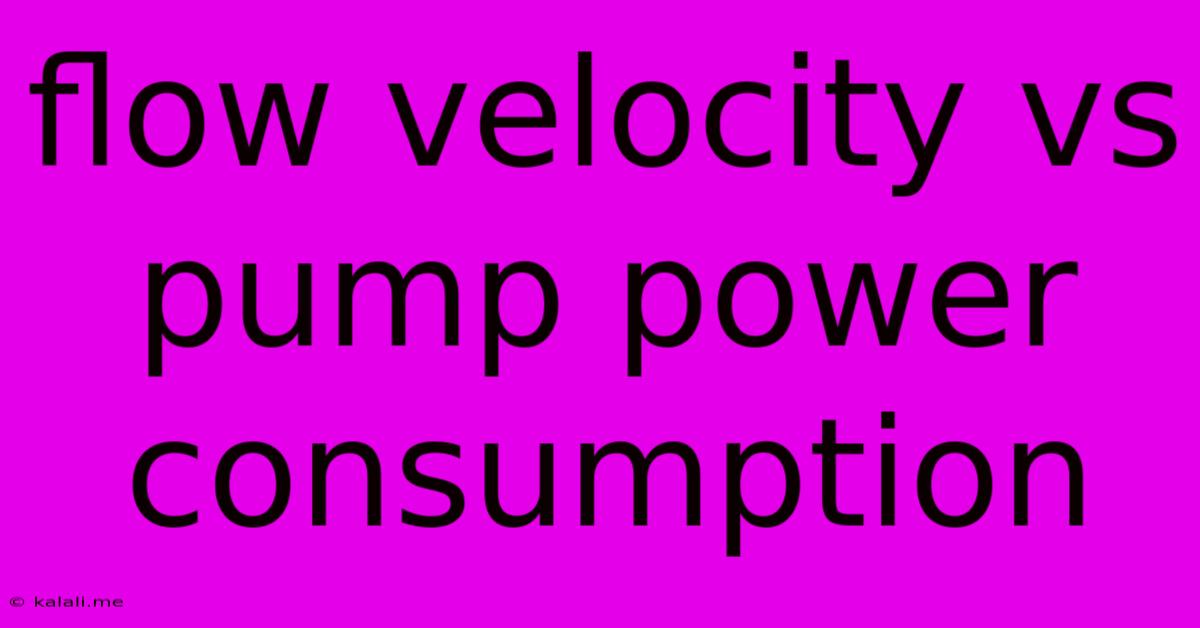Flow Velocity Vs Pump Power Consumption
Kalali
May 24, 2025 · 4 min read

Table of Contents
Flow Velocity vs. Pump Power Consumption: A Detailed Look at the Relationship
Understanding the relationship between flow velocity and pump power consumption is crucial for efficient system design and operation. This article delves into the complexities of this relationship, explaining the factors that influence power consumption and offering strategies for optimization. Optimizing your system can lead to significant cost savings in energy bills and reduced environmental impact.
Pump power consumption is directly related to the amount of energy required to move a specific volume of fluid at a certain velocity. Several key factors interplay to determine the overall power demand.
Understanding the Fundamentals: Head, Flow Rate, and Power
Before diving into the specifics, let's define some key terms:
-
Flow Rate (Q): This refers to the volume of fluid moved per unit of time, typically measured in gallons per minute (GPM) or liters per second (L/s). Higher flow rates generally require more power.
-
Head (H): Head represents the total energy required to lift and move the fluid against gravity and friction. It encompasses factors like elevation changes, pipe friction losses, and any pressure requirements at the discharge point. Higher head requires more power.
-
Pump Power (P): The power needed to drive the pump, typically measured in watts (W) or horsepower (hp). This is directly proportional to the flow rate and head.
The relationship between these three factors is often expressed using the affinity laws, which are approximate relationships that describe the changes in power with changes in flow rate and head.
The Affinity Laws and Their Implications for Power Consumption
The affinity laws provide a simplified model for understanding the relationship between flow rate, head, and pump power. They are particularly useful for predicting changes in power consumption when operating a pump at conditions different from its design point.
-
Flow Rate (Q) and Power (P): If the head remains constant, the power consumption is roughly proportional to the cube of the flow rate (P ∝ Q³). This means doubling the flow rate results in an eightfold increase in power consumption.
-
Head (H) and Power (P): If the flow rate remains constant, the power consumption is roughly proportional to the head (P ∝ H). Doubling the head roughly doubles the power consumption.
-
Flow Rate (Q) and Head (H): The relationship between flow rate and head is more complex and depends on the pump's specific characteristics. The power needed is proportional to the product of Q and H.
These relationships highlight the significant impact that even small changes in flow rate or head can have on pump power consumption.
Factors Influencing Pump Power Consumption Beyond the Affinity Laws
While the affinity laws provide a good starting point, several other factors can influence pump power consumption:
-
Pump Efficiency: The efficiency of the pump itself plays a crucial role. More efficient pumps convert a larger percentage of input power into useful work (moving the fluid), resulting in lower power consumption for the same flow rate and head.
-
Pipe Diameter and Roughness: Friction losses within the piping system directly affect head. Smaller diameter pipes and rough pipe surfaces increase friction, requiring more power to achieve the same flow rate.
-
Fluid Viscosity: The viscosity (thickness) of the fluid affects the power needed to move it. More viscous fluids require more power.
-
System Leaks: Leaks in the piping system cause a reduction in the effective flow rate, demanding higher power to maintain the desired flow at the discharge point.
-
Altitude: At higher elevations, the atmospheric pressure decreases, impacting the pump's performance and possibly requiring more power to maintain the same flow rate.
Optimizing Pump Power Consumption
Several strategies can help reduce pump power consumption:
-
Select Efficient Pumps: Choose pumps with high efficiency ratings. This is a crucial aspect of system design.
-
Optimize Piping Systems: Minimize pipe length, ensure proper pipe diameter, and use smooth pipe interiors to reduce friction losses.
-
Regular Maintenance: Regular maintenance, including cleaning and lubrication, helps maintain pump efficiency and prevents premature failure.
-
Variable Speed Drives: Using variable speed drives allows for precise flow rate control, adapting the pump speed to the actual demand, reducing power consumption during periods of low flow.
-
System Monitoring: Implementing monitoring systems allows for early detection of problems like leaks or inefficiencies, enabling timely interventions.
By understanding the relationship between flow velocity, pump power consumption, and the factors affecting it, engineers and operators can make informed decisions to optimize system performance and reduce energy costs. This understanding is essential for sustainable and efficient fluid handling operations.
Latest Posts
Latest Posts
-
How Fast Does A Comet Move
May 24, 2025
-
How To Make Whole Milk From Skim
May 24, 2025
-
8 Bit Vs 16 Bit Games
May 24, 2025
-
How To Get Woodland Mansion Map
May 24, 2025
-
Convert Quick Release To Thru Axle
May 24, 2025
Related Post
Thank you for visiting our website which covers about Flow Velocity Vs Pump Power Consumption . We hope the information provided has been useful to you. Feel free to contact us if you have any questions or need further assistance. See you next time and don't miss to bookmark.